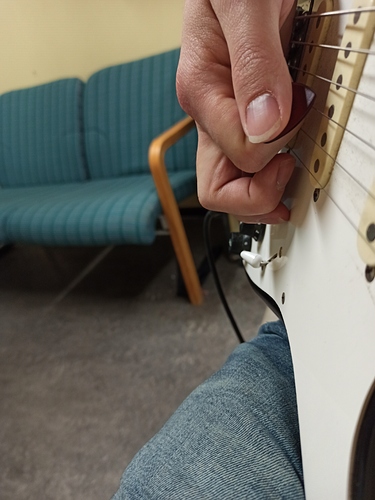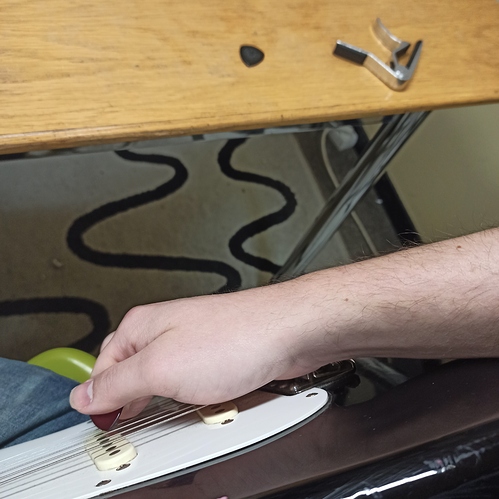Sorry for the confusion! These are all good questions.
The motion you’re making isn’t more or less “extreme” that what Marty does. It’s just a different motion. You’re making a deviation motion which is a motion where the wrist moves toward the thumb. If Marty did that with his arm position, then his pick would go straight up in the air, with an almost 90-degree escape. That’s because his arm position is so supinated. So in Marty’s case, the reason he doesn’t get a 90-degree escape is because he’s not making a deviation wrist motion. He’s making some other kind, something with forearm and fingers - it’s interesting.
But anyway, in your case, once you’ve established that you’re doing the thumb-ways type of motion, the angle of the escape is just determined by your arm position. Tilting that a few degrees toward your pinky won’t change the motion — it will still be deviation. It’ll just give you some more headroom on the escape.
Just as another example of this, when you look at players like let’s say Albert Lee or Eddie Van Halen, they use a more supinated arm position. If they made a deviation motion, the pick would go way up in the air, more like the 30 degrees you’re talking about. But when we look at Eddie for example we don’t see that. His pick still looks like it’s going flat. Drum roll please… he has chnaged his wrist motion.
We put a cool demonstration of this in the Primer at about 1:45 in this chapter:
So basically, if you have the tilted arm and you use a thumb-ways deviation motion, you get 30 degrees. If you use an Eddie-style motion, you get the 10-15 degrees escape again, but with the more tilted arm. So in your case, I’m saying, just keep the motion as you have it, and tilt the arm a little more. That’s one potential approach.
What are the downsides to this? Well, nothing as far as this motion itself is concerned. 30 or 15 or 10 doesn’t matter. But we do notice that players who change escapes, tend to use the flatter escape. This way when they switch from USX to DSX, the wrist only needs to make a small change in trajectory and it can be done fast. If you think of these picking styles like a language, someone like Eric Johnson never changes escape. He “speaks” USX all the time and all his lines are in that language. So it doesn’t matter what escape he’s using so long as he escapes.
Personally, when I’m “speaking” USX and playing things like EJ lines, or really any kind of one-way economy line that involves downstroke sweeping, I notice that I tilt a little. When I’m playing something like a three-note-per-string scale, where I might need both escapes, I revert back to the Stern-style arm position where the escape is shallow for both USX and DSX. They’re two different modes or langauges for me, and the lines I play in each fit the arm position and escape I’m using.
What you’re doing here looks pretty good. I only got into the trigger grip a few years ago. Before that I was exclusively angle pad. Getting into this grip helped me understand the relationship between grip and arm position. The trigger grip, when done in its flattest arm position, looks like Mike Stern. You can see some really good closeups of him in the chapter I linked to above. This is what it looks like you’re doing, and it looks right on target.
When I use a slightly more extended index finger grip, like angle pad, the arm position because slighly more supinated, like Andy Wood. When I use a middle finger grip, the arm position is even more supinated, like Eddie. In all of these cases you can still get the flat escape, but you’re changing the wrist motion to do it. If you go from trigger to Eddie the difference is visually obvious. If you go from trigger to Andy the difference is much less obvious. This is why I’m saying that learning the different grips helped me understand the changes these players were making — especially learning the Eddie style grip, arm position, and motion. All grips work, just choose the correct arm position and motion for each grip.
The way you should look at this is that wrist motion has like four different modes: pronated like Molly Tuttle, lightly supinated like Stern, slightly more supinated like Andy, and most supinated like Eddie, Albert Lee, and Steve Morse. Each of these setups represents the center point for that grip and arm position. When in the center point, you can get all three motions, USX, DSX, and DBX. I’ve linked to this clip before, but check out this Andy Wood example:
If you watch this in slow motion, you’ll see how Andy uses DBX at the slower speeds. As he speeds up, you’ll see he switches to a combination of DSX and USX that he can’t actually feel. If you watch the string changes in the last two repetitions closely, you can see that the downstrokes go over the string in a straight line. So that’s DSX. The upstrokes also come back over the string in a straight line, just along the opposite diagonal. But Andy’s arm position doesn’t change.
That’s how we know Andy is using the centralized for for this arm position and grip. If we were to ask him to do a downstroke sweep I would bet we would see him tilt away from that center position a little. If we asked him to play the scale again, I bet we would see him come back. If we asked him to play an upstroke sweep, I bet we would see a tilt in the opposite direction.
So… for each of these “modes” of wrist motion, I think you basically have three variations. The center point from which you do things like scale playing. This is where you will probably end up mixing USX, DSX, and DBX in a way that you can’t really feel. Then you have the slight “DWPS” type tilt for one-way economy. Then you have the slight “UWPS” tilt for upstroke economy.
So I wouldn’t worry about working on DBX specifically. I’d look at this more holistically in terms of getting wrist motion to work as a system for whichever arm postion and grip you choose. The tilted variants will have more escape and also sweeping. And the flatter variations are for pure alternate stuff where you want to mix various escapes. You probably won’t be able to feel that you’re doing this. That’s normal.
Whew! That’s a lot detail. I’m writing this out also as a reference for others who may have similar questions. This will all be in the Primer at some point, hopefully soon.
Let me know if this is helpful!





